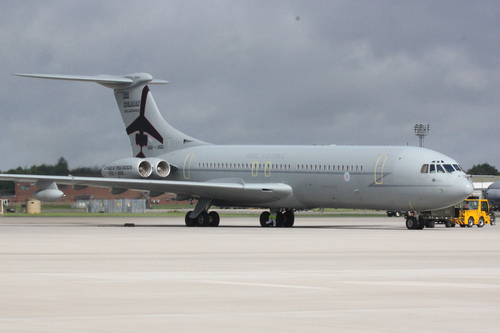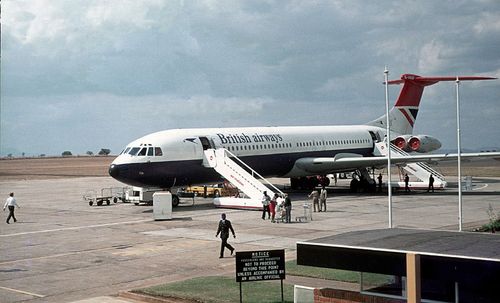All good things come to an end. While Britons are not slaves the power that for so long ensured that was case, her ability to project power at sea, has long since waned. But for a brief period in the 50s and 60s, Britain's aviation industry, like its Navy before, was amongst the best in the world. While industrial might played a big part in the success of the Airbus and Boeing, poor management played a part in Britain's fall from aviation grace, and a fine example of that poor management can be seen in the story of the Vickers VC10.
 XR808 is the last active VC10 that was delivered new to the RAF in 1966. The RAF's remaining active VC10s were purchased from East African Airways and British Airways. Photo courtesy of Jerry Gunner via flickr.com
XR808 is the last active VC10 that was delivered new to the RAF in 1966. The RAF's remaining active VC10s were purchased from East African Airways and British Airways. Photo courtesy of Jerry Gunner via flickr.com
As the development of Britain's state of art trio of jet powered V Bombers was progressing the RAF knew that to support the world-wide deployment needs of the V bombers they needed to supplement their existing fleet of propellor driven transport aircraft. So in 1951 the Air Ministry issued specifications for a 600mph long-range strategic transport aircraft to upgrade the RAF's capability.
In 1953 an order was placed for a single prototype aircraft based on an enlarged Vickers Valiant (itself one of the V bombers). Vickers realised that this transport aircraft, called the V.1000, was a good basis for a commercial airliner so with some commercial assistance from the British Overseas Airways Corporation (BOAC), Vickers set out to develop the V.1000 transport aircraft into a commercial airliner called the VC7.
At the end of 1955 the V.1000 was within months of being completed when BOAC determined that Rolls Royce would be unable to successfully deliver the new Conway jet engine needed to power the increasingly heavy VC7, they believed the higher power Conway was simply not feasible. At the same time the RAF's budget was cut and rather than continue to develop the V.1000 they decided to go with a militarised version of the De Havilland Comet Jet airliner which was already in commercial service with BOAC. BOAC announced that the Comet 4 would allow them to remain completive on the North Atlantic commercial routes well into the 60s. So in November 1955 with doubts over the engine, smaller RAF budgets and BOAC's belief that they no longer need a new larger jet airliner, the V.1000 transport and VC7 airliner projects were cancelled.
However less than a year later the House of Commons was informed that the Government had given BOAC permission to buy £44 million worth of American built Boeing 707 jet airliners so they could remain competitive on the North Atlantic routes into the mid 60s. One of the significant ironies of the purchase of the Boeings was that they were powered by the very same Rolls Royce Conway engines that BOAC claimed could not be successfully built.
While the 707 was an excellent aircraft for American routes with their wide open airports and long runways, they were a poor choice for Africa, South America and the Far East where operations at high altitude in hot climates robbed aircraft of lift and performance. Airlines using Boeing's 707 at these 'hot & high" airfields were significantly weight restricted or had to limit take offs to cooler times of the day. So less than a year after helping to kill the V.1000 and VC7, BOAC were back at Vickers door looking for them to build a long range high performance aircraft with a superior hot and high capability to the Boeings they had ordered, this time without the benefit of financial backing from the military.
Vickers' solution, the Vickers VC10, was to use four Rolls Royce Conway engines (the engines that BOAC said would never see the light of day) mounted high on the tail so that the wings could be free of all obstructions to afford maximum lift. This gave the added advantage of keeping the engines clear of the foreign objects that could be found littering the runways of Airports in these areas, and the potentially disastrous results of ingesting them. The project dragged on for a few years as BOAC changed the Aircraft's specifications and the number of aircraft in the order, but during this time the RAF, who were still looking a long range fast transport jet, became interested again.
In 1962 the VC10 finally took flight. Its ability to land and takeoff at lower speeds than the 707 meant it more than met the requirement to operate from 'challenging' airfields. The overpowered engines and extra lift from the wings required to meet the 'hot & high' challenge also meant the VC10 could carry higher payloads than it's American counterparts. It became a firm favourite with crew and passengers alike, despite their extra power those rear mounted engines provided for a very quiet cabin.
But BOAC changed it's mind again, cancelled the orders for the reaming VC10s and switched back to ordering American aircraft. BOAC calculated that the VC10 had a higher operating cost than the 707, a higher cost that was a direct result of incredibly specific requirements BOAC had laid out of the VC10.
To add insult to injury BOAC then mounted a media campaign to highlight the VC10's shortcomings, which were a direct result of their requirements, to justify their purchase of more American jet airliners. With the cancellation of BOAC's order, and their negative comments in the press, further orders failed to materialise, and the funds required to develop future versions of the aircraft dried up.
And the final irony? That clean high lift wing and powerful Conway engines which gave the VC10 it's higher take off weight allowed airlines to carry more cargo, or lift more fuel for longer flights. In the long run it turned out that BOAC's few VC10 could actually be more economical than their 707s and their quieter cabins attracted more passengers (they were advertised as having extra VC10-derness), but with cancelled ordered and the lack of foreign sales the VC10 programme was dead.
To sum up one of the problems with British industry in single paragraph; A British Airline had asked a British manufacturer to build an aircraft to meet a specific requirement that limited the aircraft's wider appeal, then rubbished it despite the aircraft meeting those exacting requirements, cancelled the order and then ultimately realised that the aircraft was cheaper to operate than the foreign manufactured aircraft they ordered to replace it.
 Delivered to BOAC in 1968 this Super VC10 (registration G-ASGP) is in later BA livery parked at Chileka International Airport in the Republic of Malawi. This aircraft went on to serve with the RAF as a mid-air refuelling tanker and was withdrawn from use in 2005. Photo courtesy of 'degahk' via flickr.com
Delivered to BOAC in 1968 this Super VC10 (registration G-ASGP) is in later BA livery parked at Chileka International Airport in the Republic of Malawi. This aircraft went on to serve with the RAF as a mid-air refuelling tanker and was withdrawn from use in 2005. Photo courtesy of 'degahk' via flickr.com
And to come full circle, the RAF's original 1951 requirement for a large fleet of high speed multi-role jet aircraft was finally met when in the early 80s the RAF bought all but one of British Airway's fleet of VC10s (BA was formed from the merger of BOAC and BEA), and the entire VC10 fleet from East African Airways. Despite difficult development and negative press the VC10 meet all its initial design requirements, carried cargo profitably and passengers comfortably, went to war and continues to provide transport and mid-air refuelling duties for Britain to this day.
Vickers built just 54 VC10s, Boeing ultimately delivered over 1,800 707s and C-135s (the military version of the 707). Britain's industrial managment might not be the best in the world, but it's engineers had built an exellent aircraft that contiunes to fly 50 years after it first took flight.